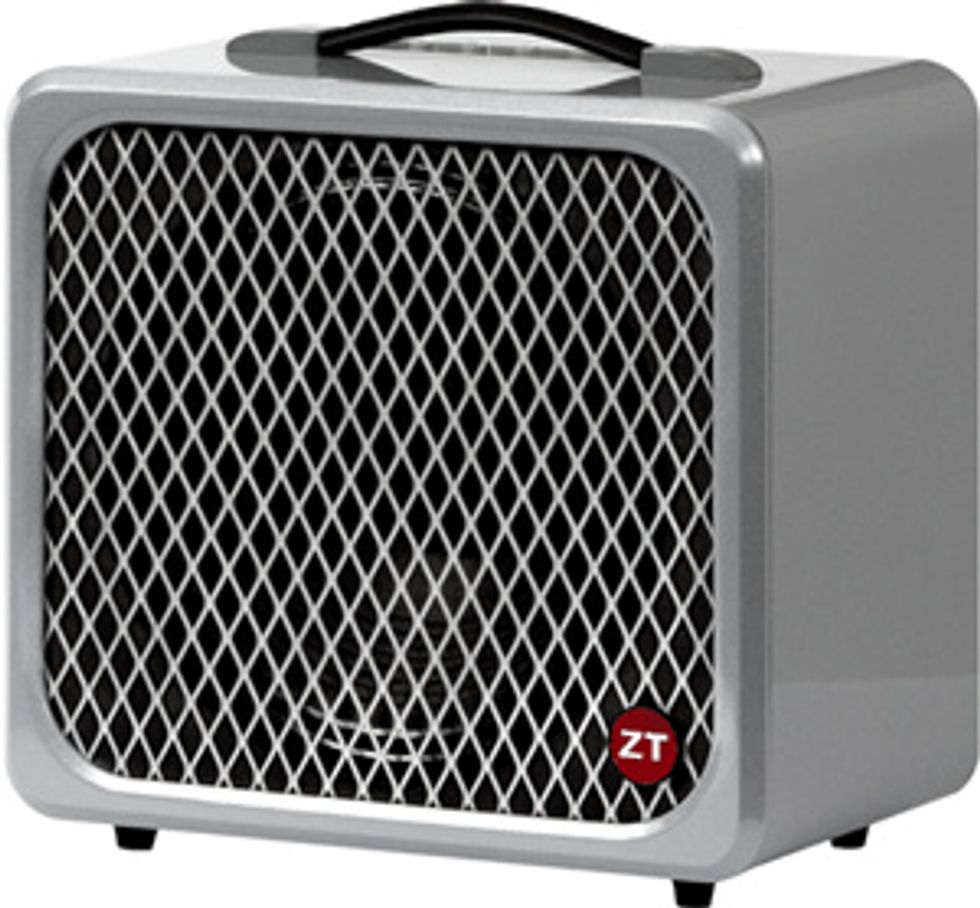The ZT Club packs a punch in an affordably priced, giggable package
 | |
Click here to watch the full-size video review. |
Teeny Town
Generally speaking, small amp buyers fall into three groups: bedroom rockers, acoustic folks, and jazzers. The new ZT Club amp is in the running for a small amp that can actually rock a club. The Club weighs in at only 22 lbs (dimensions are 14" x 15" x 9.25"), and has the same 200 watts as the Lunchbox. The Club adds reverb, along with treble and bass controls.
Features-wise, the Club is quite simple. There’s a decent, subtle digital reverb, the aforementioned treble and bass controls, an effects loop, and a stereo in for your iPod. The Volume and Gain controls are a bit puzzling. There is no overdrive happening here, so I was confused as to why ZT bothered to have the two controls instead of just one. I asked them just that. ZT president Ken Kantor replied, “We probably could have eliminated one of the controls without impacting the sound 99.9% of the time. The idea was to use the Gain knob, which is within the analog preamp circuitry, to trim the amp to match a wide variety of input levels, (i.e. different pickups or effects). It's designed almost like a pad on a studio mic preamp—not as an effect, but to allow the unit to work optimally under a wide range of conditions.”
Kantor continued, “To dig one step deeper, it's true that the Club doesn't provide the kind of crunch distortion one hears when a signal exceeds a hard clipping threshold. But, it isn't a linear transfer function like a ‘hi-fi’ solid-state amp, either. For example, the exact gain of the circuit modulates slightly with output level. This is a subtle characteristic that I, and others, have noticed about many of the really good-sounding vintage amps, where it traditionally arises from both supply voltage modulation at the driver tube(s) and saturation in the output transformer. Because of this non-linearity, (and others in the Club and Lunchbox as well), I thought it would be a good idea to have some ability to adapt to a range of inputs.”
The bottom line here is that you will have to use a stomp distortion if you want grind. The good news is that the Club not only packs a wallop that you wouldn’t expect from this little beastie, it also has a damn nice tone.
Firing it Up
Many, and I mean many solid-state amps just have a horrible, glassy-sounding top end, which is why most rockers are phobic about transistors. The Club has a really nice, round—dare I say it?—tube-like sound. And while response is a hard thing to describe—let’s say it’s how the amp makes the guitar feel to the player—the way this amp responds is also very tube-like in that spongy, pleasant way.
The box is closed, and the bass response is surprising. With a distortion box cranking, I found an amazing bass womp for great chugga-chug action. For jazz, the tone is fat and round, the response is quite even, and there’s headroom to burn. The Club has nice tones all the way. Frankly, everything about this amp caught me off guard.
Can the Club rock? Yep it sure can. The amount of sound pressure that comes out of the Club is… well, club-like. It will easily do a club gig, and with its small size and price I would be very tempted to get two and run them in stereo.
The Final Mojo
So by now you are wondering what the downside is. Well, one thing that may bother some folks is that ZT considers this a sealed deal—they don’t want you to tweak anything or even replace the speaker. I can see this being a deal-breaker for some, but it sounds great the way it is, so I’m not too concerned. My big gripe is that I like a solid pine cabinet and this one is made of medium-density fiberboard (MDF). MDF is a sound-neutral material and is fine for PA systems or stereo speakers, but I think for guitars the cab is a part of the overall tone. Plus, pine would be lighter than MDF. I would also like to see ZT supply a cover to protect that MDF and colorful finish.
My personal desires aside, this is a damn fine little amp. I do believe the Club could be the jazz amp of choice for today, just as the Polytone Mini-Brute was back in the ’70s. The power, portability, and all-around nice tone make this a good choice for any electric player.
Buy if...
You want a portable amp with some outrageous power.
Skip if...
You want your amp to provide the effects, or your perception of solid-state is stuck in the ’80s.
Rating...
Street $459 - ZT Amplifiers - ztamplifiers.com |

